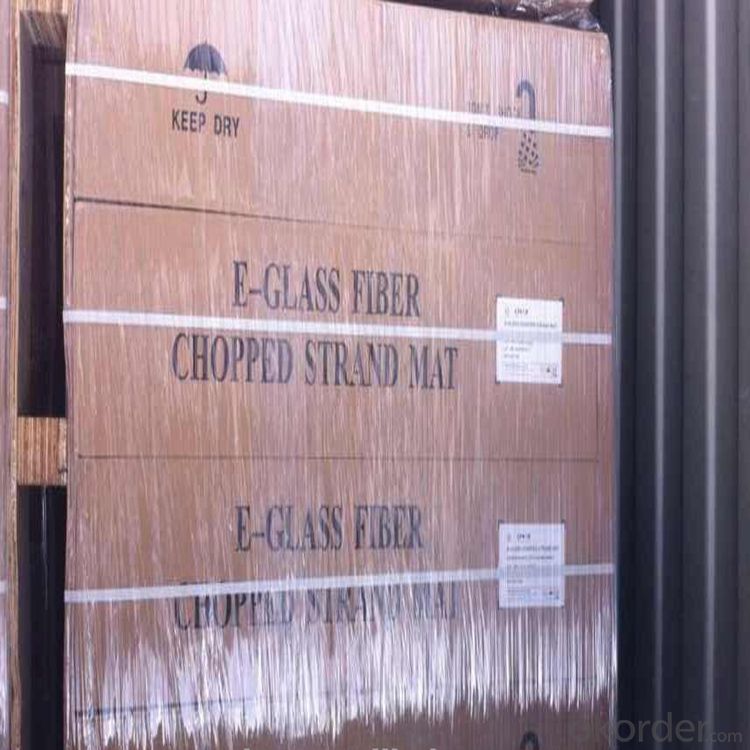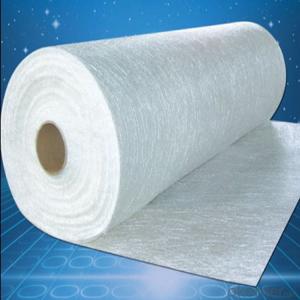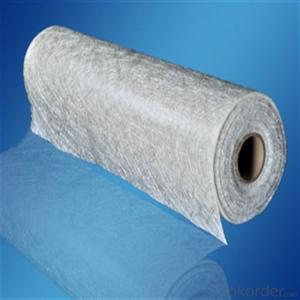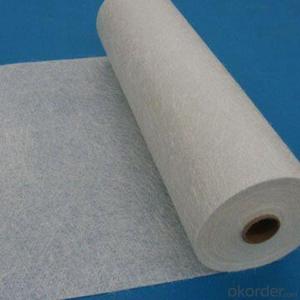Fiberglass Emulsion Chop Strand Mat
- Loading Port:
- China main port
- Payment Terms:
- TT OR LC
- Min Order Qty:
- 1 kg
- Supply Capability:
- 5000 kg/month
OKorder Service Pledge
OKorder Financial Service
You Might Also Like

Product Description:
Chopped strand mat is made from chopped glass fibers, which are bonded with powder or emulsion binders. It can be used in hand lay-up process and continuous laminating process to produce FRP products, such as plates, lighting board, hull, bathtub, cooling towers, anti-corrosion materials, vehicles.
Features:
Uniform thickness, softness and hardness good.
Good compatibility with resin, easy completely wet-out.
Fast and consistent wet-out speed in resins and good manufacturability.
Good mechanical properties, easy cutting.
Good cover mold, suitable for modeling complex shapes.
Application:
fiberglass thickness is suitable for application by hand lay-up, reinforce and machine FRP molding,
including interior decoration of vehicles, boat hulls, complete set of sanitary equipment, anticorrosive pipes, tanks, building materials, tables, chairs, panels and all kind of composite FRP products.
Specifications:
Item | Over Density | Moisture Content | Chop Density | Polyester Yarn | Width |
(g/m2) | (%) | (g/m2) | (g/m2) | (mm) | |
EMK300 | 309.5 | ≤0.15 | 300 | 9.5 | 50-3300 |
EMK380 | 399 | 380 | 19 | ||
EMK450 | 459.5 | 450 | 9.5 | ||
EMK450 | 469 | 450 | 19 | ||
EMC0020 | 620.9 | 601.9 | 19 | ||
EMC0030 | 909.5 | 900 | 9.5 |
Special products are available according to customer’s requirement.
Product Packaging:
Each Surface Tissue is wound onto a paper tube which has an inside diameter of 76mm and the mat roll has a diameter of 330mm. The mat roll is wrapped up with plastic film,and then packed in a cardboard box or wrapped up with kraft paper. The rolls can be vertically or horizontally placed. For transportation, the rolls can be loaded into a cantainer directly or on pallets.

Product Storage:
Unless otherwise specified, Chopped Strand Mat should be stored in a dry, cool and rain-proof area. It is recommended that the room temperature and humidity should be always maintained at 15℃~35℃ and 50%~75% respectively.
Company Information
CNBM (China National Building Material) Group is the largest comprehensive building materials group in China that in integrate scientific research, manufacturing and logistics into one entity. The largest building materials and equipment specialists in China. Upon State Council approval, today CNBM owned more than 300 subordinate manufacturing factories and servicing companies. There are 6 fully owned public listed companies and 11 partially owned with substantial shares public listed companies. In many of these fields, CNBM is playing the leading role in the building industry in the country.

Order Information
Ordering please specify:
1. the product code, 2. weight, 3. width, 4. order quantity, 5. packaging, 6. special requirements please specify.
FAQ:
1. How long will you get reply?
Any inquiry will be replied within 24 hours. Usually we will reply within 12 hours.
2. How long is warranty period?
We provide 3 year warranty period.
3. What is your MOQ?
Any order quantity is available.
4. Can you provide sample?
Yes, samples are in stock. we can offer free sample for you.
5. Payment terms?
We can accept L/C, T/T, Western Union, Paypal etc.
6. Do you offer OEM service?
Yes, we can print customers’ logo on the packaging;
And the size and specification can be produced and design according to your demand.
7. What is the Production Lead Time?
15-20 days for bulk production after confirm the order.
- Q:How does the stiffness of the chopped strand affect its performance?
- The stiffness of the chopped strand directly affects its performance as it plays a vital role in determining the strength, durability, and overall effectiveness of the product. A stiffer chopped strand typically results in a higher tensile strength, improved dimensional stability, and enhanced resistance to deformation or breakage. This stiffness also contributes to better mechanical properties and allows for more effective reinforcement in composite materials. Consequently, the performance of the chopped strand is significantly influenced by its stiffness, making it a crucial factor to consider in various applications.
- Q:What are the typical sustainability considerations when using fiberglass chopped strand composites?
- When utilizing fiberglass chopped strand composites, there are several sustainability factors that should be taken into consideration. Firstly, the extraction of silica sand, a non-renewable resource, is involved in fiberglass production. It is crucial to assess the environmental impact of mining and processing silica sand, as well as the potential for habitat destruction and water pollution. Another aspect of sustainability to consider is the energy consumption associated with manufacturing fiberglass composites. The production process necessitates high temperatures for melting and shaping the material, resulting in significant energy usage. This energy consumption contributes to greenhouse gas emissions and climate change. Moreover, disposing of fiberglass chopped strand composites can be challenging from a sustainability standpoint. Fiberglass is not biodegradable and can persist in the environment for an extended period. To minimize waste and environmental impact, it is important to consider proper disposal methods such as recycling or finding alternative uses for the material. Furthermore, the health and safety of workers during the manufacturing process of fiberglass chopped strand composites should be taken into account. The production and handling of fiberglass can release harmful fibers and chemicals into the air, posing health risks to workers if not appropriately controlled. Ensuring worker protection and implementing suitable safety measures are crucial for sustainability in this context. To address these sustainability considerations, various initiatives and technologies are being developed. These include the use of recycled fiberglass, the advancement of more energy-efficient manufacturing processes, and the implementation of stricter regulations and guidelines to ensure safe production and disposal of fiberglass chopped strand composites. Overall, achieving sustainability when utilizing fiberglass chopped strand composites requires careful consideration of the environmental impact of raw materials, energy consumption during production, disposal practices, and worker safety. By addressing these considerations, the use of fiberglass composites can be made more sustainable and environmentally friendly.
- Q:Is fiberglass chopped strand compatible with different joining techniques?
- Fiberglass chopped strand is indeed compatible with a range of joining techniques. It offers versatility as it can be connected through various methods, including adhesive bonding, mechanical fastening, and fusion welding. When adhesive bonding is used, a suitable adhesive is employed to connect the chopped strand either to another material or to join multiple chopped strand components together. Mechanical fastening, on the other hand, involves the use of screws, bolts, or rivets to establish a connection between the chopped strand and other materials. Fusion welding is yet another option, where the chopped strand components are joined by melting and fusing the fibers using heat. Thanks to its compatibility with different joining techniques, fiberglass chopped strand proves to be a versatile material suitable for a wide range of applications in industries such as automotive, construction, and aerospace.
- Q:Can fiberglass chopped strand be used for reinforcing polymer matrix composites?
- Fiberglass chopped strand is indeed applicable for reinforcing polymer matrix composites. This type of fiberglass is composed of randomly oriented short lengths of fiberglass strands. By combining these chopped strands with a polymer matrix like epoxy, polyester, or vinyl ester resin, a composite material can be created. The incorporation of fiberglass chopped strand enhances the strength, stiffness, and impact resistance of the polymer matrix. The arrangement of the chopped strands aids in distributing the load evenly throughout the composite, resulting in increased strength and durability. Moreover, the utilization of fiberglass chopped strand in polymer matrix composites offers numerous advantages. It is lightweight, resistant to corrosion, and possesses exceptional electrical insulation properties. Additionally, it exhibits favorable dimensional stability and can be effortlessly molded into intricate shapes. In conclusion, fiberglass chopped strand is a widely used and effective reinforcement material for polymer matrix composites, making it suitable for a diverse range of applications such as automotive components, aerospace parts, construction materials, and consumer goods.
- Q:How does the transparency of the chopped strand affect its performance?
- The transparency of the chopped strand does not necessarily affect its performance. The performance of chopped strand is primarily determined by factors such as the type of fiber used, the length and diameter of the strands, and the resin matrix it is combined with. Transparency may be more relevant in certain applications where visual aesthetics or light transmission are important, but it does not directly impact the mechanical or physical properties of the chopped strand.
- Q:Brief introduction of glass fiber cloth
- Statin (similar to unidirectional cloth). It is different from the ordinary fabric, but also can be used in the production of glass fiber reinforced, three-dimensional woven fabrics and other forms of three-dimensional fabric. In certain applications will also further roving short cut, as well as for corrosion resistant occasions, which is generally used in glass mat. The shape of a solid fabric is massive. Alkali free glass fiber tape is commonly used in the manufacture of high strength, rectangular, unidirectional fabrics. Single warp fabric is a kind of coarse and fine warp weft four by breaking satin or long satin fabric, wet mechanical strength shall meet the requirements, greatly improves the shear strength of composites and resistance damage tolerance, and then use the barbed needle acupuncture. It is a continuous glass strand by throwing silk device randomly thrown in continuous mesh belt, such as winding, mould. The dumbbell shaped fabric, flat selvedge and weft density; the fabric made of laminated material to avoid the pollution of the process . The fiber in the continuous glass fiber felt is continuous. The most typical braid is a layer of warp and weft overlap together. Glass cloth is mainly used for producing all kinds of electric insulation laminate.
- Q:Can fiberglass chopped strand be used in the production of recreational vehicles?
- Yes, fiberglass chopped strand can be used in the production of recreational vehicles. Fiberglass chopped strand is a versatile material that is commonly used in the manufacturing of various fiberglass-reinforced plastic (FRP) products, including recreational vehicles. It provides excellent strength and durability, making it an ideal choice for constructing the body panels, roofs, floors, and other structural components of RVs. The chopped strand is typically mixed with a resin matrix, such as polyester or epoxy, to form a composite material that is lightweight, yet strong. This composite can be molded into different shapes and sizes, allowing for the customization of RV designs and the creation of complex structures. One of the key benefits of using fiberglass chopped strand in RV production is its resistance to corrosion and weathering. Recreational vehicles often face harsh outdoor conditions, including exposure to UV radiation, moisture, and temperature fluctuations. Fiberglass reinforced with chopped strand provides a protective barrier against these elements, ensuring the longevity and durability of the RV's exterior. Additionally, fiberglass chopped strand offers excellent impact resistance, which is crucial for withstanding the vibrations and shocks encountered during travel on rough roads. It also has good thermal and electrical insulation properties, providing comfort and safety to the occupants of the recreational vehicle. Overall, fiberglass chopped strand is a reliable and widely used material in the production of recreational vehicles. Its strength, durability, resistance to corrosion, and versatility make it an excellent choice for constructing various components of RVs, contributing to their overall performance and longevity.
- Q:What are the typical health and safety considerations when working with fiberglass chopped strand?
- When handling fiberglass chopped strand, it is important to keep in mind several health and safety factors: 1. Personal Protective Equipment (PPE): It is essential to wear suitable PPE when working with fiberglass chopped strand. This may include a respirator or dust mask to protect against breathing in airborne particles, safety glasses or goggles to prevent eye irritation or injury, and gloves to safeguard the hands from potential skin irritation or cuts. 2. Ventilation: Sufficient ventilation is crucial when dealing with fiberglass chopped strand. This helps reduce the inhalation of airborne particles and decrease the concentration of potentially harmful fumes or dust in the work area. If working indoors, ensure the area has good ventilation, and if possible, use exhaust fans or other ventilation systems to remove airborne contaminants. 3. Handling and storage: Fiberglass chopped strand can have sharp edges, so it is important to handle it carefully to avoid cuts or punctures. Proper storage of the material is also crucial to prevent accidental exposure or damage. Store the fiberglass chopped strand in a dry and secure location, away from heat sources or open flames. 4. Dust control: Fiberglass chopped strand can generate fine particles or dust during handling, cutting, or sanding. To minimize exposure to these particles, it is important to implement effective dust control measures. This may involve using wet methods, such as wet cutting or wet sanding, to reduce the generation of airborne dust. Additionally, using vacuum systems or dust collectors can help capture and contain any dust that is generated. 5. Training and awareness: Proper training and awareness are crucial when working with fiberglass chopped strand. All individuals working with this material should receive education on the potential hazards, proper handling techniques, and emergency response procedures. It is important to follow all safety guidelines and protocols to minimize the risk of injury or exposure to harmful substances. By considering these health and safety factors, individuals can ensure a safer working environment when dealing with fiberglass chopped strand. It is always advisable to consult safety guidelines and regulations specific to your country or region to ensure compliance with local requirements.
- Q:Can fiberglass chopped strand be used in the production of wind turbine hubs?
- Yes, fiberglass chopped strand can be used in the production of wind turbine hubs. Fiberglass chopped strand is a type of glass fiber reinforcement that is commonly used in various industries, including the manufacturing of wind turbine components. It provides strength, stiffness, and durability to the final product, making it an ideal material for wind turbine hubs. The fiberglass chopped strand can be combined with resin and molded into the desired shape, providing a lightweight and robust hub that can withstand the forces and stresses experienced during wind turbine operation. Additionally, fiberglass is corrosion-resistant and has excellent fatigue resistance, making it well-suited for long-term use in wind turbine hubs.
- Q:Can fiberglass chopped strand be used for reinforcing ceramic matrix composites?
- Fiberglass chopped strand is not suitable for reinforcing ceramic matrix composites. These composites need materials that can withstand high temperatures and offer exceptional mechanical properties in elevated temperatures. However, fiberglass may lack the required thermal stability to endure the extreme temperatures necessary for ceramic matrix composites. Moreover, the thermal expansion coefficients of fiberglass and ceramics often differ significantly, resulting in poor compatibility and potential composite failure. Consequently, alternative fibers such as carbon fibers or silicon carbide fibers, which are known for their high-temperature resistance, are commonly employed for reinforcing ceramic matrix composites.
1. Manufacturer Overview |
|
|---|---|
| Location | |
| Year Established | |
| Annual Output Value | |
| Main Markets | |
| Company Certifications | |
2. Manufacturer Certificates |
|
|---|---|
| a) Certification Name | |
| Range | |
| Reference | |
| Validity Period | |
3. Manufacturer Capability |
|
|---|---|
| a)Trade Capacity | |
| Nearest Port | |
| Export Percentage | |
| No.of Employees in Trade Department | |
| Language Spoken: | |
| b)Factory Information | |
| Factory Size: | |
| No. of Production Lines | |
| Contract Manufacturing | |
| Product Price Range | |
Send your message to us
Fiberglass Emulsion Chop Strand Mat
- Loading Port:
- China main port
- Payment Terms:
- TT OR LC
- Min Order Qty:
- 1 kg
- Supply Capability:
- 5000 kg/month
OKorder Service Pledge
OKorder Financial Service
Similar products
New products
Hot products
Related keywords





























